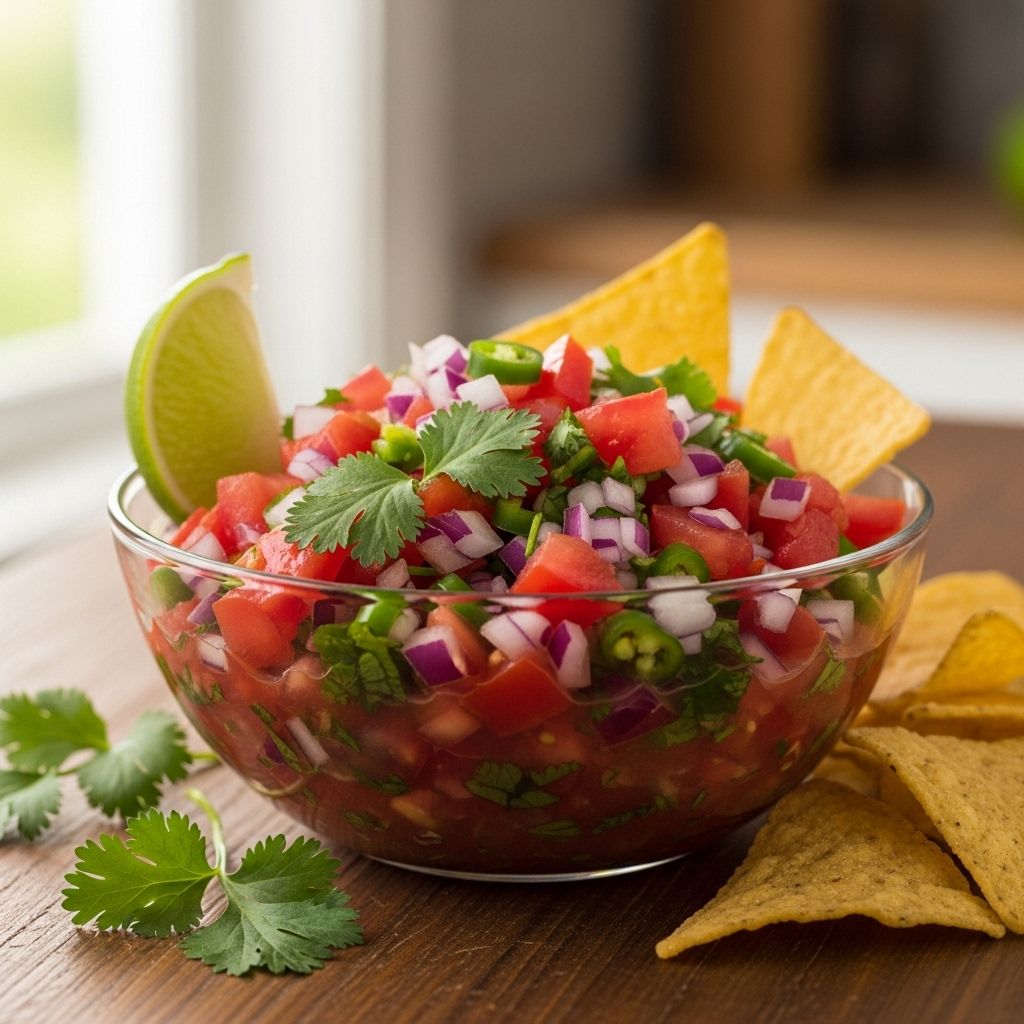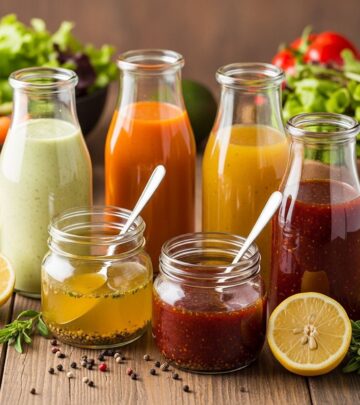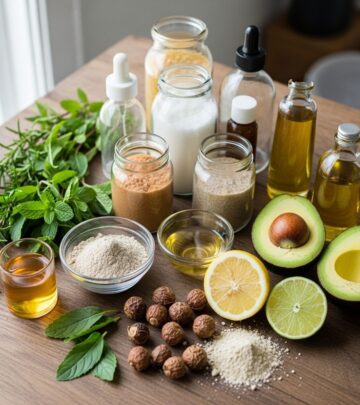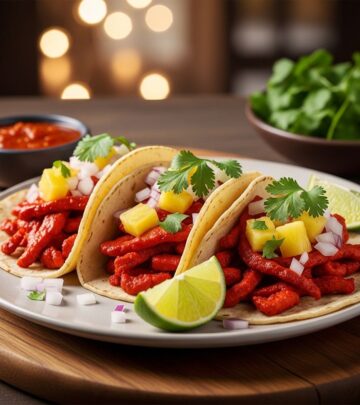Fresh Tomato Salsa Recipe: Easy 15-Minute Homemade Delight
Master the art of creating vibrant, flavorful homemade salsa with garden-fresh ingredients

Image: HearthJunction Design Team
The Best Fresh Tomato Salsa: A Vibrant Homemade Delight
Fresh tomato salsa, known as ‘pico de gallo’ in authentic Mexican cuisine, is a vibrant, chunky mixture bursting with freshness and flavor. Unlike store-bought versions that often contain preservatives and excessive sodium, homemade salsa celebrates the natural taste of ripe tomatoes enhanced by aromatic herbs and zesty lime. This recipe yields approximately 40 servings of restaurant-quality salsa that will elevate your next gathering or family dinner to new heights.
The beauty of homemade salsa lies in its simplicity. With just a handful of fresh ingredients and about 15 minutes of preparation time, you can create a versatile condiment that complements everything from tortilla chips to grilled meats. The key to exceptional salsa lies in the quality of ingredients and the balance of flavors—the sweetness of ripe tomatoes, the pungency of onions, the heat of jalapeños, and the brightness of lime juice all harmonize to create a symphony of taste.
Essential Ingredients for Perfect Tomato Salsa
The foundation of any outstanding salsa begins with selecting the right ingredients. Each component plays a crucial role in developing the complex flavor profile that makes fresh salsa so irresistible. Here’s what you’ll need to gather before embarking on your salsa-making journey:
Primary Ingredients
- 3 cups freshly chopped tomatoes – Choose firm, ripe tomatoes for the best flavor and texture. Roma or vine-ripened varieties work exceptionally well as they contain fewer seeds and less water than other varieties.
- 1 cup finely diced onion – White or red onions provide the perfect pungent contrast to the sweet tomatoes. Red onions add a beautiful color contrast and slightly milder flavor.
- ½ cup chopped green bell pepper – This adds a fresh, slightly sweet crunch that complements the softer texture of the tomatoes.
- ¼ cup minced fresh cilantro – This herb is quintessential to authentic salsa, providing a distinctive citrusy, slightly peppery note.
- 2 tablespoons fresh lime juice – Beyond adding brightness, lime juice helps preserve the salsa’s freshness and enhances all other flavors.
- 4 teaspoons chopped fresh jalapeño pepper (including seeds) – Adjust according to your heat preference. Keep the seeds for extra spiciness or remove them for a milder version.
Seasoning Elements
- ½ teaspoon ground cumin – This warm, earthy spice adds depth and authenticity to your salsa.
- ½ teaspoon kosher salt – Enhances all the flavors and helps to draw out moisture from the vegetables.
- ½ teaspoon ground black pepper – Adds a subtle heat different from the jalapeño’s capsaicin-based spiciness.
Step-by-Step Preparation Process
Creating the perfect batch of fresh tomato salsa is straightforward, requiring minimal cooking skills. Follow these simple steps for consistent results every time:
Preparation Steps
- Gather all ingredients – Having everything measured and prepared before mixing ensures balanced flavors and proper texture.
- Combine ingredients – In a medium-sized bowl, gently stir together the chopped tomatoes, diced onion, green bell pepper, minced cilantro, fresh lime juice, jalapeño pepper, ground cumin, kosher salt, and black pepper.
- Mix carefully – Use a folding motion rather than aggressive stirring to maintain the chunky texture. The goal is to distribute the ingredients evenly without crushing the tomatoes.
- Serve and enjoy – The salsa can be enjoyed immediately, but allowing it to rest for at least 30 minutes before serving allows the flavors to meld beautifully.
Pro Tips for Exceptional Results
While the basic recipe is foolproof, these professional insights will elevate your salsa from good to extraordinary:
- Tomato preparation – For less watery salsa, remove the seeds and excess juice from the tomatoes before chopping.
- Texture control – Chop ingredients to a consistent size for balanced flavor in each bite. Aim for ¼-inch pieces for a traditional texture.
- Flavor development – For the best flavor, prepare the salsa at least one hour before serving and refrigerate it to allow the ingredients to meld together.
- Heat adjustment – The recipe calls for jalapeños with seeds included, but you can customize the heat level by removing some or all seeds, or by substituting with milder peppers like Anaheim or poblano.
Nutritional Benefits and Dietary Considerations
Beyond its incredible taste, fresh tomato salsa offers impressive nutritional benefits, making it a guilt-free addition to your culinary repertoire:
Health Benefits
This vibrant condiment is packed with vitamins, minerals, and beneficial plant compounds:
- Low in calories – With primarily vegetables and minimal added fats, salsa is a nutritional powerhouse with few calories.
- Rich in vitamins – Tomatoes provide vitamins A and C, while cilantro adds vitamin K and antioxidants.
- Source of lycopene – The abundant tomatoes supply lycopene, a powerful antioxidant associated with reduced risk of heart disease and certain cancers.
- Anti-inflammatory properties – Several ingredients, including onions and cilantro, contain compounds that may help reduce inflammation.
Dietary Adaptations
This recipe is naturally suitable for many dietary preferences and can be easily adapted for specific needs:
- Gluten-free – All ingredients are naturally gluten-free, making this perfect for those with celiac disease or gluten sensitivity.
- Vegan and vegetarian – Contains only plant-based ingredients.
- Low-sodium option – Simply reduce or omit the added salt for a lower-sodium version.
- AIP/Paleo adaptations – Omit the black pepper and nightshades (tomatoes, bell pepper, jalapeños) and substitute with AIP-friendly alternatives like diced mango, cucumber, and herbs.
Creative Serving Suggestions and Pairings
While traditionally served with tortilla chips, fresh tomato salsa’s versatility extends far beyond this classic pairing:
Traditional Accompaniments
- Mexican classics – Elevate tacos, burritos, enchiladas, or quesadillas with a generous spoonful of fresh salsa.
- Tortilla chips – The classic vehicle for enjoying salsa, preferably using homemade or high-quality store-bought chips.
- Complementary dips – Serve alongside guacamole and queso for a complete Mexican-inspired appetizer spread.
Innovative Applications
Think beyond the traditional chip and dip scenario with these creative serving ideas:
- Protein enhancer – Use as a fresh topping for grilled chicken, fish, or steak to add flavor without excessive calories.
- Breakfast boost – Spoon over scrambled eggs or an omelet for a vibrant morning meal.
- Salad addition – Mix into a green salad as a chunky, flavorful dressing alternative.
- Sandwich spread – Use as a condiment on sandwiches or burgers instead of mayo or ketchup.
- Grain bowl topper – Add brightness to rice, quinoa, or other grain bowls.
Storage Recommendations and Shelf Life
Proper storage is essential to maintain the salsa’s freshness and prevent spoilage:
Short-term Storage
For immediate use within a few days:
- Refrigeration – Store in an airtight container in the refrigerator for up to 5-7 days. The lime juice helps preserve freshness, but quality diminishes after about a week.
- Drainage consideration – Tomatoes will continue to release liquid during storage. You may need to drain excess liquid before serving leftovers.
Long-term Preservation
For enjoying your salsa beyond its fresh shelf life:
- Freezing option – While texture will change somewhat, salsa can be frozen in airtight containers or freezer bags for up to 3 months. Thaw in the refrigerator before serving.
- Canning consideration – Fresh salsa recipes generally aren’t suitable for water bath canning without significant modifications to ensure proper acidity levels for safety.
Variations and Customizations
The beauty of homemade salsa lies in its adaptability. Consider these variations to customize the recipe to your preferences or to utilize seasonal ingredients:
Heat Level Adjustments
- Mild version – Remove all seeds and membranes from jalapeños, or substitute with milder peppers like Anaheim.
- Medium heat – Use the recipe as written, with jalapeños including some seeds.
- Fiery option – Add serrano or habanero peppers for significant heat, or include a pinch of cayenne pepper.
Flavor Profile Variations
- Roasted salsa – Char tomatoes, onions, and peppers under a broiler or on a grill before chopping for a deeper, smokier flavor.
- Fruity twist – Add diced mango, peach, or pineapple for a sweet-savory combination.
- Corn salsa hybrid – Incorporate 1 cup of fresh or charred corn kernels for added sweetness and texture.
- Avocado addition – Fold in diced avocado just before serving for creaminess (note: this will reduce shelf life).
- Black bean enhancement – Stir in 1 cup of rinsed and drained black beans for a more substantial dip or side dish.
Troubleshooting Common Issues
Even with a straightforward recipe, occasional challenges may arise. Here are solutions to the most common salsa-making issues:
Texture Problems
- Too watery – Remove tomato seeds and pulp before chopping, or let the finished salsa drain in a fine-mesh strainer for 15-20 minutes.
- Too chunky – Chop ingredients more finely, or pulse briefly in a food processor for a more uniform consistency.
Flavor Imbalances
- Too acidic – Add a pinch of sugar to balance excessive acidity from the lime juice or tomatoes.
- Too bland – Increase salt gradually (¼ teaspoon at a time), or add more lime juice and cilantro.
- Too spicy – Add more tomatoes to dilute the heat, or include a small amount of sugar to balance the capsaicin.
- Bitter taste – This may result from bitter onions or too much cilantro stems. Use sweet onions and focus on cilantro leaves rather than stems.
Frequently Asked Questions
Q: Can I make this salsa ahead of time for a party?
A: Yes, you can prepare it up to 24 hours in advance. The flavor actually improves after the ingredients have had time to meld together in the refrigerator. Just drain any excess liquid before serving.
Q: Is there a substitute for cilantro for those who don’t enjoy its flavor?
A: Fresh parsley makes an excellent substitute for cilantro. While it won’t provide the same distinctive flavor, it offers a similar bright, herbaceous quality. You could also try a smaller amount of fresh basil or mint for a different but complementary flavor profile.
Q: How can I make this salsa less spicy without compromising flavor?
A: Remove all seeds and membranes from the jalapeños before chopping them, as this is where most of the heat resides. You can also reduce the amount of jalapeño or substitute with a milder pepper like poblano or bell pepper.
Q: Can I use canned tomatoes instead of fresh?
A: While fresh tomatoes provide the best flavor and texture for this recipe, you can use drained, diced canned tomatoes in a pinch, especially during winter when fresh tomatoes lack flavor. The texture and taste will be different but still enjoyable.
Q: Why did my salsa turn bitter after a day in the refrigerator?
A: Bitterness can develop from oxidation of the cilantro or from using too much green bell pepper. To prevent this, make sure to use only fresh ingredients and consider reducing the amount of bell pepper if you’re sensitive to its potential bitterness.
With this comprehensive guide, you’re now equipped to create the perfect batch of fresh tomato salsa for any occasion. Whether you’re serving it as part of a festive spread or incorporating it into everyday meals, this versatile condiment will brighten your table and delight your taste buds with its vibrant flavors and textures.
References
Read full bio of Anjali Sayee












